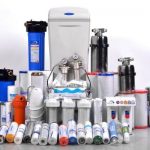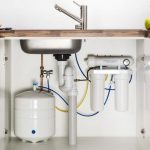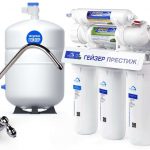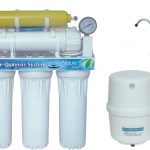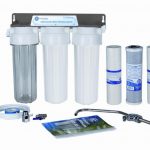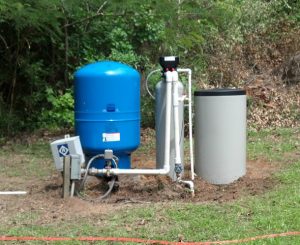 How can people who are accustomed to urban, purified water feel comfortable in a country cottage? How not to worry about your health? How not to get food poisoning and not to suffer from various unpleasant sensations associated with poor-quality water in the country? There are simple answers to all these questions. The cottage is able to become a favorite vacation spot or permanent residence in the warm season. To do this, it is enough to know how to choose a water filter in the country.
How can people who are accustomed to urban, purified water feel comfortable in a country cottage? How not to worry about your health? How not to get food poisoning and not to suffer from various unpleasant sensations associated with poor-quality water in the country? There are simple answers to all these questions. The cottage is able to become a favorite vacation spot or permanent residence in the warm season. To do this, it is enough to know how to choose a water filter in the country.
Content
Why and from what to filter water in the country
Outside urban treatment systems, water is never clean and high quality. The main reason is the high level of technogenic pollution, even away from megacities. This factor becomes even more significant when you consider how much water is collected in large-scale underground layers.
The water collected from the well can be clean and transparent in appearance. From the well - go muddy even with a thorough pumping out of the pumps at the beginning of the season due to changes in the level of the underground layer. The first test that water must pass in the country is sedimentation. After 3-5 days (or even several hours), a precipitate will necessarily form at the bottom of the collected vessel, which may be in the form of flakes if the liquid is very dirty.
Other definitions of water quality are made in the laboratory. This is the only way to understand exactly which undesirable substances need to be removed from the liquid so that it is useful and does not harm the body.
To trust charlatans selling various filters and doing express analysis right on the spot is not worth it. This category of promoters is usually equipped with simple electrolysis units. During their work, the compounds dissolved in water are transformed and together with mineral salts and impurities, they fall to the bottom by unappetizing looking flakes.
As a result of laboratory studies and seeding, a clear picture of the content in water is obtained:
- bacteria and pathogens;
- iron salts;
- heavy metal compounds;
- some groups of toxic substances;
- hydrogen sulfide and nitrogen;
- hard impurities.
Based on the test results, various types of filters for cleaning, cartridges of compact units are selected. A decision is also made on the need to install a disinfection unit.
It is not worth neglecting measures of cleaning and disinfection. The problem is that absolutely pure aquifers do not exist in nature. When passing through layers of soil and rocks, suspended solids, salts of heavy metals are removed from the water, and minerals are saturated.
However, the harmful compounds formed by the dissolution of fertilizers, products, so to say, filling suburban toilets, bacteria do not disappear. Outside the city, this phenomenon is most pronounced. Therefore, the first step before choosing a filter for water in a private home is to conduct a laboratory analysis.
Types of filters by installation method
At a modern summer cottage you will not surprise anyone with a well for taking water from underground aquifers. There are situations when a well is used to provide water to a country house.The choice of a specific water treatment model is made on the basis of existing conditions. The following technical means are applied:
- well filters that delay small and large mechanical suspensions even at the stage of pumping fluid. They not only extend the life of the equipment, but also help to better purify the water;
- flow systems requiring specific pressure indicators for efficient operation;
- reverse osmosis systems, the most controversial category of treatment plants.
Such filters are widely used in cottages where water is pumped by pumping stations. However, there are products for owners of country houses who do not have good pressure in the water supply.
- Filters - jugs. A very popular product, absolutely not tied to the pipe and pump system. Water is simply poured into it, for example, collected in a well. In retail, you can choose almost any cartridge for the purchased model. For example, purifying water from iron and its compounds.
- Nozzles on the crane. These devices allow you not to waste time and money on modifying the water supply. The nozzle is simply put on, fixed with a clamp or a standard clamping device. On sale there are many models that are screwed into the tap instead of the standard divider. This type of equipment not only has the best cleaning performance, but also allows you to get more water per unit time, in comparison with filters - jugs.
What exactly to choose should be decided on the basis of the parameters of the water supply system, the usual volumes of water consumption. Often, for a simple rest in the country, a filter jug is enough, with which you can dial a kettle after waiting only 5-10 minutes.
However, most owners of a country house decide to install a full-fledged system for purifying the supplied water. In this case, several degrees of purification are established; various types of filters are selected depending on specific conditions.
Membrane or flow filters
Before proceeding to the description of filters, their purpose and features, it is worth highlighting the issue of the applied working element, a barrier to pollution. Marketers vying to praise membrane models, describe their merits and the ability to get almost crystal clear water. In practice, flow filters are used. Understanding why is easy.
- The heart of the membrane filter is a special structure in which there are many miniature cells. They are so small that they pass (as the advertisement says) only water molecules. This leads to good filtering results, but there is always a “BUT” group.
- Firstly, the membrane model is expensive.
- Secondly, little water per unit time passes through it.
- Thirdly, for effective work at the inlet of the filter a lot of pressure must be created.
- Fourth, the outlet water is not entirely useful. It is literally scorched, containing virtually no substances useful to the body.
And the last thing that owners of summer cottages and country houses do not like: the majority of membrane filter models work on the principle of redundancy. To obtain a liter of pure water, 5-8 times more is passed through the system. The excess merges into the sewer or cesspool.
- Flow-through filters are built on a classic fiber structure of specially bound linen or synthetic fibers, softeners and salt neutralizers have a flask with an absorbent.
- Prices for replacement components that have a recommended final life are low.
- There are types of filters on sale for removing various groups of impurities, for their work often you do not need to create high pressure at the inlet.
The throughput of flow-through models also does not pose any difficulties.
Therefore, the owners of country houses, if they choose filters for water purification for a summer residence, give preference to flow models.They are inexpensive, easy to install, have wide parameters of the working area. And on the basis of laboratory analyzes of water, you can choose the optimal set of flasks and replaceable blocks to get the liquid with the optimal parameters at the outlet.
Types of filters according to the principle of operation
When the question arises of how to build a multi-stage cleaning system, people often make obvious mistakes, believing that only one type of filter is able to cope with the task as a whole. In practice, this is not so. In order to increase the replacement time for cleaning blocks, to reduce the costs of continuous operation and to obtain water of the required quality at the outlet, filters with different working patterns and purpose are always used.
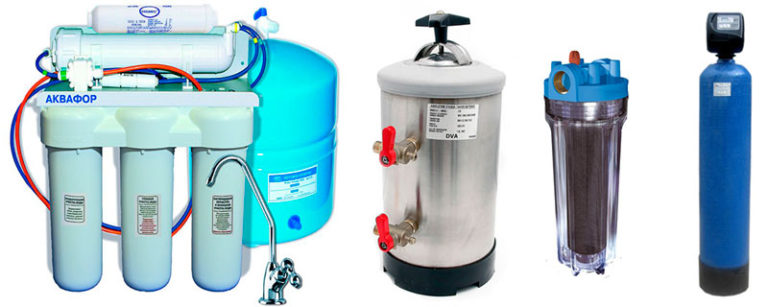
Coarse Filters
Coarse filters must be installed directly at the inlet of the water supply to the house. Their task is to retain large insoluble impurities. Nodes are executed collapsible, to maintain normal operation they must be periodically cleaned. Determining that the coarse filter is clogged is simple. Pressure drops in the water supply system, in the most advanced cases, impurities appear. In this case, you need:
- unscrew the upper protective cover;
- pull out the mesh element;
- rinse thoroughly and dry;
- clean (if any) dirt from the inside of the filter.
Today, not only classic models are made of brass, which are difficult to unwind for cleaning due to the lid attachment, but also plastic ones. We replace the inner mesh element, over time it can rot and break through in some places.
Strainer
The mesh filter allows you to remove extremely fine suspensions with a particle size of 50 to 500 microns. Its design is more complex, but the principle of service is the same as that of a rough cleaning product. The filter must be disassembled, after shutting off the water supply, pull out the working element, rinse, dry. The assembly of the structure is carried out in the reverse order.
Today, more advanced models are offered for sale. Such a filter is equipped with a drainage outlet. When filled with dirt, the system flushes itself. In this way, consistent, stable cleaning characteristics are maintained. This class of models is able to offer additional benefits. For example, a pressure gauge to control the operation of the water supply system, a damping valve to smooth out pressure surges that can harm household appliances.
Cartridge filter
The cartridge filter is a simple and inexpensive flow type model. Its main working element is a block of fiber structure formed by rope twisting or multilayer fabric. On sale you can buy a replacement unit designed to filter small particles, from 0.5 microns and above.
The advantages of a cartridge filter in its ability to retain a wide range of mechanical suspensions. In addition, it retains viscous colloids and water-soluble substances, which are not capable of coarse mesh systems. The cartridge reliably holds pollution, requires a change after pumping a large number of cubic meters of water.
Pressure filter
The pressure filter works according to technology similar to the cartridge model. Its feature is high bandwidth. It is reasonable to apply a pressure filter if a sufficiently low pressure is observed in the water supply system, and the pump has to raise water in a multi-story building.
However, you have to pay for performance. The pressure filter well retains fine mechanical suspensions, colloids and water-soluble compounds, but the minimum size of impurities removed from the liquid is 30 microns. Another disadvantage of this type of cleaner is the large size of the flask and the inability to work at low temperatures.
On sale it is easy to find models equipped with a simple cleaning system. This can be an expensive option, which automatically flushes itself, or a fairly inexpensive product, to remove dirt from which you must press the fluid switch.
Fine filters
As the name implies, the task of fine filters is to carry out the final part of the water treatment process. But modern devices are capable of more. Some of them change the characteristics of a liquid, softening it or removing a certain class of chemical compounds from it.
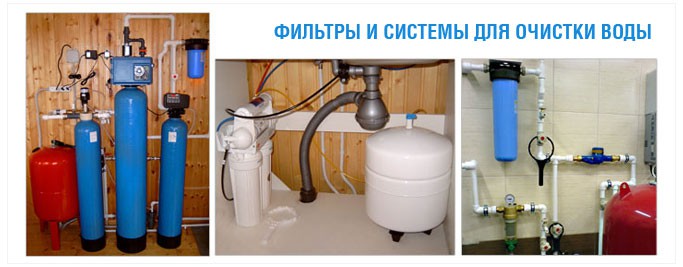
Sorption filter
The sorption filter is considered universal. It removes microorganisms, bacteria, chlorine compounds, salts of heavy metals from a liquid. The principle of operation is quite simple:
- water is supplied to the filter unit;
- passing through the working fluid (most often activated carbon), the liquid is purified;
- flasks need to be changed periodically.
If laboratory analysis has been performed, a special flask can be selected to equip the sorption filter. On sale there are universal ones with activated carbon, special mixtures for disinfecting or reducing the level of iron compounds. The lack of a sorption filter in low throughput and the need for frequent replacement of the flask.
Ion exchange filter
Ion exchange filters always have additional functionality. They reduce the hardness of water, retaining mineral compounds. Their working fluid is a special ion-exchange resin. This type of filter is capable, in addition to the main functionality:
- reduce the level of glandular compounds;
- remove chlorine and its compounds from water;
- neutralize the content of individual elements, for example, sodium, silver, fluorine;
- carry out ultra-thin cleaning.
The lack of models of this class in the limited service life of the filtration unit. Also, to guarantee safety, it is recommended to install a carbon sorption filter after it.
Advantages and disadvantages
Each filter has its own set of advantages. You can take the jug with you wherever you go, the pressure model - allows a lot of water to pass through, and the ion exchange model allows you to fine-tune it, neutralizing the most undesirable fluid parameter. It is simply impossible to clearly identify any product flaws, since each should be carefully selected based on future operating conditions. For example:
- a long time filtering in a jug will not be a problem if trips to the country are periodic and a lot of water is simply not needed;
- the need to replace cartridges or flasks is not a problem if the component’s resource is not developed or used up to the end during the season;
- The pressure that is needed for the optimum operation of the sorption filter is not a problem for owners of powerful pumps.
Therefore, the only advice that can be given to those who wish to build a cleaning system is to correctly analyze the existing conditions and select the necessary filters based on them.
Which to choose
In conclusion, we can give some recommendations regarding the rapid construction of an effective water treatment system.
Filter type
In a multi-stage system, only the second and third processing queues are selected. There are several standardized schemes:
- at normal mineralization of water - a coarse filter, cartridge or sorption block is installed;
- with increased mineralization - a bundle of a mesh and ion-exchange filter works well;
- for water with a high level of the content of compounds of one or another element - a bunch of mesh, absorption (with the flask of the required type) or ion-exchange filter is used.
The best course of action is to immediately install a multi-stage cleaning unit after a coarse filter. In this case, you can install the desired set of flasks and get water with the desired characteristics at the outlet. An excellent option is to install an additional step for ultraviolet irradiation. Such an installation reliably kills all bacteria.
If you do not need to clean a large stream of water, you can buy a filter jug of large capacity at the cottage. Having purchased cartridges of the necessary type for it, it is easy to get water with optimal characteristics.
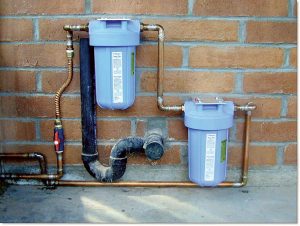
Degree of purification
It is not worth neglecting the quality of cleaning.It is worth conducting field experiments only if the pump does not cope with the filter resistance or another problem arises in the operation of the water supply network. In this case, it is worth replacing cartridges or flasks on models with a large indicator of the minimum size of the retained particles.
In general, a multi-stage system does an excellent job of cleaning. However, for families with small children it is recommended to install a forced mineralization unit as the last stage of processing. It allows you to get water with the optimal content of nutrients and mineral compounds.
Reverse osmosis
Reverse osmosis is a system that must be applied correctly. Installation without strapping produces unhealthy water. This has been proven by numerous laboratory and medical studies. Reverse osmosis water is an absolutely dead, chemically neutral distillate.
In order to get a healthy fluid, the reverse osmosis system must be connected to a forced mineralization unit. Coarse, fine filters and an ultraviolet irradiation device are installed in front of it.
Those who are thinking about acquiring a reverse osmosis system should know about the second main drawback of the installation. She has extremely low productivity. Therefore, you need to buy a model with an intermediate storage tank. But even her amount of water processed per hour may not be enough to meet the needs of the family.
Price
The cost of various systems is not only the price of models in the store. It includes:
- price of replaceable cartridges;
- the number of recommended replacements for components with a finite life;
- motor resource, the amount of water that one replaceable element is capable of processing.
An approximate scheme of analysis of the final cost most clearly looks when buying filter jugs. For example, Aquaphor and Barrier products are approximately the same, have equal capacity. But the cartridge for the first costs a little more and passes through itself 30% less water to the recommended replacement.
It becomes clear that the Barrier wins at the price of the main function, but the final choice may depend on the personal preferences of the buyer. Tempted, for example, with digital indicators of filling or cartridge status of the Aquafor jug.
Similarly, it is worth choosing other filter models. A thorough analysis is the way to reduce waste and increase overall comfort when using a water treatment system.
Conclusion
Modern and technological, water filters in the country will allow you to drink better quality water. Today, there are many models on sale for every need.
Some will be extremely attractive to people traveling to the country for a picnic. Others will help those who do not want to spend money and tinker with changing the water supply network. Still others provide complete comfort with permanent residence.
To make the best choice, it is necessary to analyze the characteristics of the water in the laboratory and correctly determine the set of filters of the multistage treatment system.
